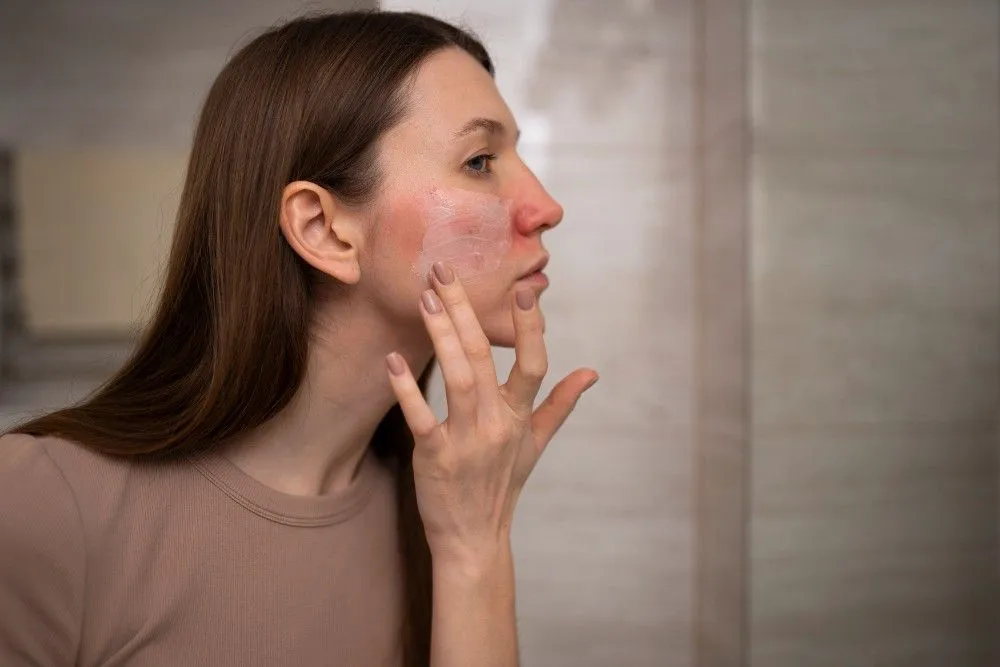A bacterial infection causes Staphylococcal scalded skin syndrome (SSSS). It causes discolored, blistering skin areas that peel off. The impacted regions may be burnt.
Ritter's illness is another term for SSSS. The earliest signs could include a fever and skin flushing. Someone can then get blister patches that rupture readily. The skin's top layer may begin to peel, revealing discolored, wet regions beneath.
Since the skin syndrome is more common in infants and children under six, it also causes adults with chronic kidney disease or a weaker immune system.
In this article, we will look into what staphylococcal skin scalded syndrome, its causes, its symptoms, and treatment, so please read carefully to know more.
 Staphylococcal scalded skin syndrome (SSSS) is a serious skin illness that often affects young children and newborns under six. It is also known as Ritter's disease. The infection is triggered by the bacterium staphylococcus aureus.
SSSS is caused by a toxin produced by bacteria in the Staphylococcus genus.
The bacteria in someone with SSSS generate a toxin that breaks apart the upper region of the epidermis, the skin's top layer.
Toxic substances bind to and break apart portions of skin cells, allowing them to cling to neighboring skin cells. As a result, epidermal cells split from the following layer of the skin.
The distinctive skin changes in infants may appear around the diaper area. They usually appear on the chest, hands, arms, legs, or faces of older children and adults.
Also Read: Fungal Skin Infections 101
Staphylococcal scalded skin syndrome (SSSS) is a serious skin illness that often affects young children and newborns under six. It is also known as Ritter's disease. The infection is triggered by the bacterium staphylococcus aureus.
SSSS is caused by a toxin produced by bacteria in the Staphylococcus genus.
The bacteria in someone with SSSS generate a toxin that breaks apart the upper region of the epidermis, the skin's top layer.
Toxic substances bind to and break apart portions of skin cells, allowing them to cling to neighboring skin cells. As a result, epidermal cells split from the following layer of the skin.
The distinctive skin changes in infants may appear around the diaper area. They usually appear on the chest, hands, arms, legs, or faces of older children and adults.
Also Read: Fungal Skin Infections 101
What is Staphylococcus Scalded Skin Syndrome?
 Staphylococcal scalded skin syndrome (SSSS) is a serious skin illness that often affects young children and newborns under six. It is also known as Ritter's disease. The infection is triggered by the bacterium staphylococcus aureus.
SSSS is caused by a toxin produced by bacteria in the Staphylococcus genus.
The bacteria in someone with SSSS generate a toxin that breaks apart the upper region of the epidermis, the skin's top layer.
Toxic substances bind to and break apart portions of skin cells, allowing them to cling to neighboring skin cells. As a result, epidermal cells split from the following layer of the skin.
The distinctive skin changes in infants may appear around the diaper area. They usually appear on the chest, hands, arms, legs, or faces of older children and adults.
Also Read: Fungal Skin Infections 101
Staphylococcal scalded skin syndrome (SSSS) is a serious skin illness that often affects young children and newborns under six. It is also known as Ritter's disease. The infection is triggered by the bacterium staphylococcus aureus.
SSSS is caused by a toxin produced by bacteria in the Staphylococcus genus.
The bacteria in someone with SSSS generate a toxin that breaks apart the upper region of the epidermis, the skin's top layer.
Toxic substances bind to and break apart portions of skin cells, allowing them to cling to neighboring skin cells. As a result, epidermal cells split from the following layer of the skin.
The distinctive skin changes in infants may appear around the diaper area. They usually appear on the chest, hands, arms, legs, or faces of older children and adults.
Also Read: Fungal Skin Infections 101
What are the causes of Staphylococcus scalded skin syndrome?
Many people have Staphylococcus aureus, sometimes known as "Staph," germs on their skin or noses. These bacteria are normally innocuous, but when they reach the body through an injury, they can cause illness. This genus contains around 30 different forms of bacteria, the most prevalent of which is Staphylococcus aureus. When bacteria of this genus create toxins, they enter the circulation and migrate to the skin, causing SSSS. Toxins disrupt a chemical called desmoglein, which is required for epidermal cells to attach. With damaged desmoglein, the epidermis, the outer layer of skin, cannot keep its shape. It peels away, exposing discolored, wet skin underneath. At the place the staph infection enters the body, blisters that contain pus or fragile, clear, or yellow fluid may form. If the illness affects one location, clinicians call it "bullous impetigo." Doctors detect SSSS when it moves via blood circulation to other regions. Also Read: What Is the Difference Between a Bacterial and Viral Infection?What are the symptoms of Staphylococcus scalded skin syndrome?
Staphylococcus skin scalded syndrome causes certain symptoms that may be similar to those of other disorders. These are some examples:- Flu-like symptoms include tiredness and fever.
- Irritability.
- Blisters.
- Weakness.
- A painful throat.
- Conjunctivitis.
What is the treatment for Staphylococcus scalded skin syndrome?
For the treatment of the infection, a person might take antibiotics orally. They may also undergo therapy by IV injections, which allows the medicine to enter circulation immediately. Furthermore, healthcare providers may apply sterile gauze or bandages to the lesions to reduce discomfort, restrict future damage, and prevent infection. Open wounds can be treated with ointments and lotions.Antibiotics often used in this kind of treatment include:
- Cefazolin
- Nafcillin
- Oxacillin
What is the risk factor for this syndrome?
Newborns are especially vulnerable because they lack antibodies to combat the illness, and their kidneys are dysfunctional and cannot assist in eliminating it from the body. Because most adults have these antibodies, SSSS is uncommon in adults; nevertheless, individuals with immune systems that are weak may be at risk. Adults are included:- Suffering from HIV, also those with AIDS.
- Undergoing Chemotherapy.
- Using drugs that weaken the immune system.
- Having impaired kidney function.
- Having chronic kidney disease.
What are the complications of the syndrome?
When Staphylococcus skin scalded syndrome affects significant body regions, a lack of skin can make it difficult to regulate body temperature. As moisture escapes via exposed regions, dehydration may result. Staph infections are infectious, and SSSS epidemics can arise in childcare centers and treatment facilities. Isolating somebody suffering from SSSS can safeguard others. Severe instances may necessitate care in a burn unit. SSSS has an annual mortality rate of less than 5% in youngsters. Early detection and treatment improve the chances of a successful outcome. Research on Predictors of Mortality in Staphylococcus aureus Bacteremia. Also, some include;- Shock.
- Bacteremia occurs when an infection enters the bloodstream.
- Sepsis occurs when the body's reaction to an infection causes tissue damage.
- Hypothermia.
- The disease spread
- Infection from a different source.
How can you prevent Staphylococcus scalded skin syndrome?
The first step in preventing SSSS is to avoid staph infections. Those at greatest risk of staph infections include:- Having a compromised immune system or a persistent sickness.
- They have been in a hospital facility for some time.
- People have dialysis.
- People with one or more open wounds.
- After cleansing the cuts and scrapes with soap and water, they are covered with sterile coverings.
- Using soap and water, wash your hands.
- Using a hand sanitizer containing alcohol.
- Personal goods such as razors and towels should not be shared.
- After entering any healthcare institution, carefully wash your hands.
Conclusion-
Staphylococcus scalded skin syndrome is common for some people to have staph bacteria on their skin and noses. Only when the bacteria called staph enter the body by a cut, wound, or tainted food can they cause problems. Staph infections can manifest themselves in a variety of ways. Skin infections are the most prevalent, and they might be slight and recover in a few days, or they can be serious and take a long time to heal. It is always recommended for people to get treatment if they experience symptoms of the infection. People with weaker immune systems should seek medical attention immediately as they feel they have an illness. Book an Online Appointment With The Best Dermatologist Doctors in India.
Reviewed by







